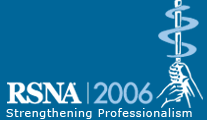
Abstract Archives of the RSNA, 2006
LL-NM2089-H04
Assessment of Respiratory Lung Motion in Patients with Chronic Obstructive Pulmonary Diseases with Respiratory-gated SPECT Image-derived 3D Displacement Vector Images
Scientific Posters
Presented on November 28, 2006
Presented as part of LLNM-H: Nuclear Medicine
Kazuyoshi Suga MD, Presenter: Nothing to Disclose
Yasuhiko Kawakamii, Abstract Co-Author: Nothing to Disclose
Hideeyuki Iwanaga MD,PHD, Abstract Co-Author: Nothing to Disclose
Naofumii Matunaga MD, Abstract Co-Author: Nothing to Disclose
Regional respiratory lung motion was analyzed by 3D displacement vector images obtained from non-rigid image fusion process of respiratory-gated inspiratory and expiratory perfusion SPECT.
24 patients (pts) with chronic obstructive pulmonary diseases (COPD), 10 pts with pulmonary thromboembolism (PTE) and 6 healthy controls underwent gated perfusion SPECT, using a triple-headed SPECT system and a respiratory tracking device. Gated inspiration and expiration SPECT were reconstructed from 1/8 data centered at peak inspiration and expiration for each regular respiratory cycle, respectively. In non-rigid image co-registration process of gated expiratory SPECT to inspiratory SPECT, the direction and magnitude of displacement of each voxel on expiratory SPECT were expressed as 3D vectors. This 3D vector image was used for qualitative and quantitative analysis of respiratory regional motion, which was correlated with Technegas study.
In controls, 3D vector images showed regular, symmetric respiratory lung expansion towards caudal direction, with the largest motion in lower dorsal portion and the smallest motion in upper ventral portion. In contrast to controls with regular, symmetrical motion, these images frequently showed focally irregular and decreased motion in COPD pts, with occasional paradoxical motion. In 23 (95%) COPD pts, lung areas with the worst or paradoxical motion were consistent with those with the most severely decreased radioactivity on Technegas SPECT. All PTE pts, except for one with pleural effusion showed regular, symmetrical motion, similar to healthy controls. The normalized cranio-caudal lung motion index of 0.25 ± 0.01 in the entire lungs of COPD pts was significantly less compared with that of 0.43 ± 0.08 in controls and that of 0.40 ± 0.11 in PTE pts (both; P < 0.01). This index significantly correlated with FEV1 and %FEV1 in all subjects (P = 0.0015 and P = 0.0002, respectively).
3D vector images contribute to qualitative and quantitative assessment of regional respiratory lung motion in COPD and PTE.
Regional ventilation assessment with 3D displacement vector images obtained from gated perfusion SPECT
Suga, K,
Kawakamii, Y,
Iwanaga, H,
Matunaga, N,
Assessment of Respiratory Lung Motion in Patients with Chronic Obstructive Pulmonary Diseases with Respiratory-gated SPECT Image-derived 3D Displacement Vector Images. Radiological Society of North America 2006 Scientific Assembly and Annual Meeting, November 26 - December 1, 2006 ,Chicago IL.
http://archive.rsna.org/2006/4440963.html

